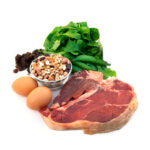Key Facts
- Protein is vital for your body’s health.
- Most teens need to get 40-60g of protein a day through food or beverages.
- Protein supplements aren’t necessary if you eat a well-balanced diet.

Protein is needed to build and repair your muscles, make and maintain hair and skin, fight against infections, and carry oxygen in your blood. Proteins are made up of twenty different building blocks, called amino acids. Your body can make some amino acids, but there are nine that your body can’t make (we call these “essential amino acids”), and the only way to get them is through the food you eat. It’s important to eat a variety of protein foods every day to make sure your body gets all the essential amino acids.
What foods are high in protein?
Plant foods such as legumes (beans, lentils, and peas), nuts, peanut butter, seeds, and soy foods (edamame, soymilk, and tofu) are all high in protein. Animal foods such as meat, fish, turkey, chicken, eggs, milk, cheese, and yogurt are also food sources high in protein.
How much protein do I need each day?
The amount of protein that you need daily, or the recommended daily allowance (RDA), depends on your age and body size, but most teens need, on average, between 40 and 60 grams of protein each day. If you want to figure out exactly how much you need, you’ll need to do a little math.
If you’re 11-13 years old: Multiply your weight in pounds by 0.455; this gives you about how many grams of protein you need each day.
If you’re 15-18 years old: Multiply your weight in pounds by 0.36 to estimate how many grams of protein you need each day.
Keep in mind that this is just an estimate. If you are very active and play sports, you may need more protein than someone who is not as active to repair the muscles you are breaking down during your activity. While these calculations can be helpful, you most likely can meet your protein needs without knowing the exact amount. It may be more helpful to know how much protein is in the foods you eat. For comparison, 3 ounces of meat is approximately the size of a deck of cards. Your fist is approximately the size of ½ cup.
The table below lists some good sources of protein and the grams of protein in each serving.
| Food | Serving Size | Grams of protein per serving |
| Tuna | 3 ounces | 20 grams |
| Hamburger | 3 ounces | 19 grams |
| Chicken | 3 ounces | 21 grams |
| Shrimp | 3 ounces | 20 grams |
| Tempeh | 1/2 cup | 19 grams |
| Yogurt, low fat | 1 cup | 12 grams |
| Greek Yogurt | 1 cup | 20 grams |
| Tofu | 1/2 cup | 10 grams |
| Lentils, cooked | 1/2 cup | 9 grams |
| Cow’s milk | 1 cup | 8 grams |
| Peanut butter | 2 tbsp | 8 grams |
| Almond butter | 2 tbsp | 7 grams |
| Sunbutter (peanut free) | 2 tbsp | 7 grams |
| Kidney beans, cooked | 1/2 cup | 8 grams |
| Cheese | 1 ounce | 7 grams |
| Egg, cooked | 1 large | 7 grams |
| Soy milk | 1 cup | 7 grams |
| Hummus | 1/3 cup | 6 grams |
| Miso | 2 tbsp | 4 grams |
| Quinoa, cooked | 1/2 cup | 4 grams |
| Bulgur, kasha, oats, cooked | 1/2 cup | 3 grams |
| Almonds | 1/4 cup | 8 grams |
| Peanuts | 1/4 cup | 9 grams |
What’s the deal with protein supplements?
There are many different protein supplements that come as powders, shakes, and bars.
If you’re thinking of taking a protein supplement, keep these facts in mind:
- Most teens get more than enough protein from food; therefore, extra supplements don’t have any benefit.
- Protein supplements don’t increase muscle mass, strength, or endurance – the keys to building new muscle are 1) proper training and recovery, 2) eating a balance of carbohydrates and protein after exercise, and 3) eating enough calories throughout the day.
- Since protein powders and supplements are not regulated by the FDA, some products may contain ingredients that can be harmful to your body and can be potentially dangerous.
- Protein supplements are very expensive.
Be sure to talk to your health care provider (and dietitian) if you’re taking a protein supplement or if you’re thinking about taking one.
How often should I eat foods with protein in them?
Protein is a filling nutrient, so it’s a good idea to eat some at every meal and at most snacks to feel satisfied and not hungry. Our bodies have no way of storing protein so you can’t eat it all at one meal and assume that your body will have enough at other times. The table below includes some protein-rich food ideas for meals/snacks.
| Breakfast | Snack | Dinner | |
|
|
|
Our health guides are developed through a systematic, rigorous process to ensure accuracy, reliability, and trustworthiness. Written and reviewed by experienced healthcare clinicians from Boston Children's Hospital, a Harvard Medical School teaching hospital and consistently ranked as a top hospital by Newsweek and U.S. News & World Report, these guides combine clinical expertise, specialized knowledge, and evidence-based medicine. We also incorporate research and best practices from authoritative sources such as the CDC, NIH, PubMed, top medical journals, and UpToDate.com. Clinical specialists and subject matter experts review and edit each guide, reinforcing our commitment to high-quality, factual, scientifically accurate health information for young people.

